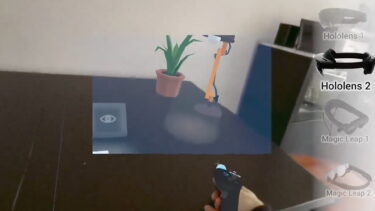Quest Pro vs. Hololens Field of View Comparison

Passthrough systems have great advantages in field of view. A Quest Pro demo illustrates how big the difference is to AR headsets.
The narrow field of view of augmented reality devices such as Hololens and Magic Leap is one of the main reasons why the technology fails in impressing consumers. Even newer products like Magic Leap 2 display AR elements in a window of just 44 degrees horizontally and 53 degrees vertically. Larger AR objects get cut off at the sides.
Although waveguide technology progressed in recent years, a major breakthrough in field of view is a holy grail.
Advantages and disadvantages of mixed reality headsets
So-called mixed reality headsets like Meta Quest Pro (review) and Lynx R-1 (report) take a different approach. These devices record the environment via integrated cameras and reconstruct a digital image on opaque VR displays. This technique is called passthrough. Since the world is no longer viewed through a piece of glass or plastic but is fully digitized, it can be freely manipulated afterward.
The design is identical to VR headsets, which is why mixed reality headsets can achieve a field of view of 100 degrees or more. But that is only one of many advantages of passthrough technology.
There are disadvantages of mixed reality headsets too. Like:
- the currently rather poor digital reconstruction capability of the visible world,
- a larger form factor, and
- risks compared to AR headsets with transparent optics.
- Motion sickness
- Accidents that could result from the technology failing and leaving users in the dark.
A partial view of the AR world
But let's get back to the topic of field of view. Developer Gabriele Romagnoli has created a demo for Meta Quest Pro using the 3D design tool ShapesXR, which illustrates the differences in the field of view.
In a video posted on Linkedin, Romagnoli captures his desk from the Quest Pro's passthrough perspective. Among other things, an interface, a houseplant, and a table lamp are digitally superimposed in front of him.
The developer then simulates the much narrower field of view of a Hololens, Hololens 2, Magic Leap, and Magic Leap 2, in which these and other digital elements only appear in sections. At the end of the video, he opens the field of view again.
"The field of view (FOV) of the current generation of augmented reality glasses is a real limitation," Romagnoli writes in the post.
He does not address the limitations of current passthrough technology. For example, it is currently difficult to see content on smartphone displays and monitors or make out fine details in the environment with Quest Pro. Passthrough technology, like waveguides, still has a long way to go before it is ready for the mass market.
Note: Links to online stores in articles can be so-called affiliate links. If you buy through this link, MIXED receives a commission from the provider. For you the price does not change.